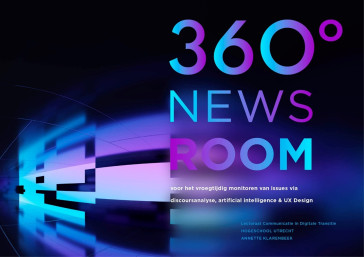Social media zijn vandaag de dag niet meer weg te denken. Het online gesprek gaat over merken, bedrijven, mediapersonality’s en meer. Liggen er ook kansen op social media voor educatieve instellingen zoals het Leeuwarder Lyceum om deze social media in te zetten?
DOCUMENT

Abstract Chapter 4: Basing ourselves on a literature review and expert interviews we create an overview of methods and tools to identify and respond to ethical questions used in healthcare, social work, police and the military. We identify six main types of methods or tools that can support professionals or organisations in dealing with ethical issues. Some of these methods are already used in CT or could be used. Some methods or tools are targeted at individual professionals or small groups, whilst others are targeted at the organisational level. The methods and tools are described in brief. Samenvatting boek: Wat is ethisch wel en wat niet geoorloofd? De aanslagen die de Europese hoofdsteden teisteren wrijven het ons in: terrorismebestrijding is noodzakelijk en is onlosmakelijk verbonden met de moderne samenleving. De inlichtingendiensten en andere organisaties die zich hiermee bezighouden, stuiten echter telkens op de vraag hoe ver zij mogen gaan. Waar liggen de grenzen? Wat is ethisch wel en wat niet geoorloofd? En vooral: hoe gaan professionals met deze soms levensgrote dilemma's om? In deze Engelstalige uitgave reflecteren wetenschappers, terrorismebestrijders en ethici op dit zeer actuele thema.
MULTIFILE
For successful energy transitions, social acceptance of innovative technologies is essential. In order to determine the contributing factors, the acceptance of bio-digestion in The Netherlands was analyzed. A discourse analysis of 200 newspaper articles was conducted to answer the question: how do different parties speak about bio-digestion? Discourse analysis is suitable for making underlying concerns and dilemmas of people more explicit. Thus, one can be more in line with people’s sensitivities in communication and policy, both of which play a crucial role in facilitating transition. The results show that there is little support for bio-digesters in residential areas. The relation between municipalities and residents is poor and asymmetric. The municipalities emphasize their role as experts, thus reinforcing incomprehension. Furthermore, they do not take responsibility and avoid confrontations, contradicting research on the significance of discussions when dealing with innovations (Leeuwis & Aarts, 2011).
DOCUMENT
Communicatieprofessionals geven aan dat organisaties geconfronteerd worden met een almaar complexere samenleving en daarmee het overzicht verloren hebben. Zo’n overzicht, een ‘360 graden blik’, is echter onontbeerlijk. Dit vooral, aldus diezelfde communicatieprofessionals, omdat dan eerder kan worden opgemerkt wanneer de legitimiteit van een organisatie ter discussie staat en zowel tijdiger als adequater gereageerd kan worden. Op dit moment is het echter nog zo dat een reactie pas op gang komt als zaken reeds in een gevorderd stadium verkeren. Onderstromen blijven onderbelicht, als ze niet al geheel onzichtbaar zijn. Een van de verklaringen hiervoor is de grote rol van sociale media in de publieke communicatie van dit moment. Die media produceren echter zoveel data dat communicatieprofessionals daartegenover machteloos staan. De enige oplossing is automatisering van de selectie en analyse van die data. Helaas is men er tot op heden nog niet in geslaagd een brug te slaan tussen het handwerk van de communicatieprofessional en de vele mogelijkheden van een datagedreven aanpak. Deze brug dan wel de vertaling van de huidige praktijk naar een hogere technisch niveau staat centraal in dit onderzoeksproject. Daarbij gaat het in het bijzonder om een vroegtijdige herkenning van potentiële issues, in het bijzonder met betrekking tot geruchtvorming en oproepen tot mobilisatie. Met discoursanalyse, AI en UX Design willen we interfaces ontwikkelen die zicht geven op die onderstromen. Daarbij worden transcripten van handmatig gecodeerde discoursanalytische datasets ingezet voor AI, in het bijzonder voor de clustering en classificatie van nieuwe data. Interactieve datavisualisaties maken die datasets vervolgens beter doorzoekbaar terwijl geautomatiseerde patroon-classificaties de communicatieprofessional in staat stellen sociale uitingen beter in te schatten. Aldus wordt richting gegeven aan handelingsperspectieven. Het onderzoek voorziet in de oplevering van een high fidelity ontwerp en een handleiding plus training waarmee analisten van newsrooms en communicatieprofessionals daadwerkelijk aan de slag kunnen gaan.
In het project werken onderzoekers van het Lectoraat samen met publieke organisaties toe naar een tool waarmee onderstromen in het publieke debat rondom issues eerder kunnen worden opgemerkt. We exploreren met welk algoritme we patronen in geruchtvorming en mobilisatie kunnen opsporen, en tevens hoe we de interactie tussen newsroom-analisten en de output van een monitoring tool het beste kunnen vormgeven.Doel Het doel van dit project is een brede en structureel toepasbare aanpak van het issuemanagement: Hoe kunnen de communicatieprofessionals van publieke organisaties potentiële issues op sociale media vroegtijdig opmerken? Resultaten We willen dit bereiken door enerzijds kennis en inzicht te vergaren en anderzijds de uitkomsten daarvan voor publieke organisaties te vertalen in praktische handgrepen: tools, handleiding, training. Looptijd 01 oktober 2022 - 30 september 2024 Aanpak Via cases ingebracht door de praktijkpartners en focusgroepen staan we in nauw contact met het consortium. In de eerste werkpakketten onderzoeken we de verschillende cases aan de hand van discoursanalyse. De inzichten die we hierbij opdoen, gebruiken we vervolgens om te bekijken hoe we de interactie tussen mens en machine het beste kunnen vormgeven en wel zo dat er ten behoeve van de communicatie en het management van issues via interactieve visualisaties steeds weer triggers afgegeven worden. Op basis van de opgedane inzichten richten we een interface in. Deze maakt het analisten en communicatieprofessionals mogelijk om vroegtijdig issues te signaleren.
In het project werken onderzoekers van het Lectoraat samen met publieke organisaties toe naar een tool waarmee onderstromen in het publieke debat rondom issues eerder kunnen worden opgemerkt. We exploreren met welk algoritme we patronen in geruchtvorming en mobilisatie kunnen opsporen, en tevens hoe we de interactie tussen newsroom-analisten en de output van een monitoring tool het beste kunnen vormgeven.
